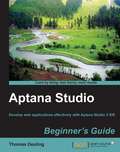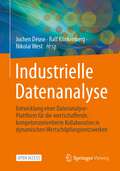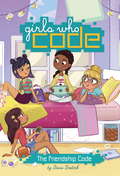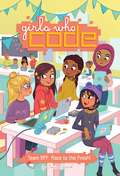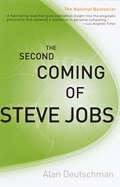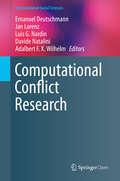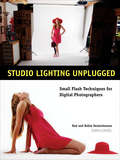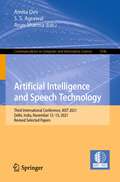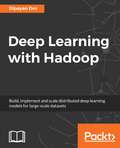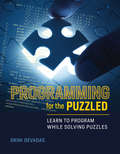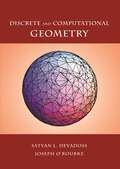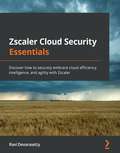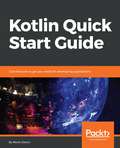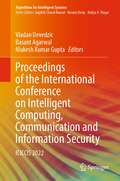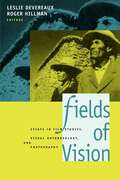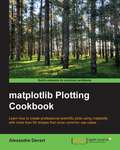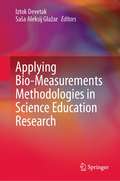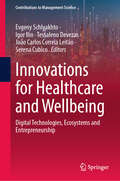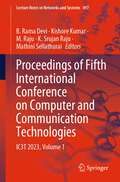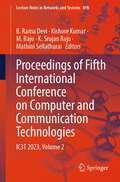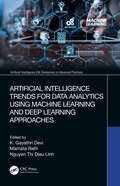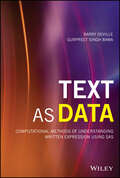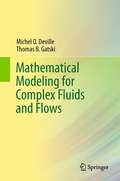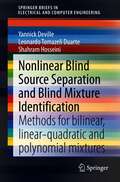- Table View
- List View
Aptana Studio Beginner's Guide
by Thomas DeulingAccompanied by the plenty of example code and step-by-step instructions, this book will escalate you from a novice to an expert in no time. This book is for anyone who is looking for an IDE for effectively developing web applications. You will find this book interesting if you are working with common web technologies such as HTML5, JavaScript, or PHP. This book assumes no prior knowledge of Aptana Studio 3 or the named web technologies.
Industrielle Datenanalyse: Entwicklung einer Datenanalyse-Plattform für die wertschaffende, kompetenzorientierte Kollaboration in dynamischen Wertschöpfungsnetzwerken
by Jochen Deuse Ralf Klinkenberg Nikolai WestDieses Open Buch schlägt eine Brücke zwischen Theorie und Praxis für das produzierende Gewerbe im Zeitalter der Digitalisierung, der Industrie 4.0 und der Künstlichen Intelligenz. Es ist das Resultat eines vierjährigen Forschungsprojekts, das unter der Leitung des Instituts für Produktionssysteme der Technischen Universität Dortmund und der RapidMiner GmbH in Zusammenarbeit mit zwölf weiteren Partnern durchgeführt wurde. Das Hauptziel des Projekts war die Entwicklung einer Datenanalyse-Plattform zur Förderung einer effektiven und kompetenzorientierten Zusammenarbeit in dynamischen Wertschöpfungsnetzwerken.Die zwanzig Beiträge in diesem Sammelband liefern umfassende Einblicke in die Forschungsergebnisse und schildern die gemeinsamen Erfahrungen der Partner aus produzierenden Unternehmen, Software- und Hardware-Anbietern sowie Forschungseinrichtungen. Im Fokus steht die Entwicklung von Lösungen, die in einem modularen Referenzbaukasten zusammengefasst sind. Dieser Baukasten unterstützt industrielle Datenanalysen und deren Integration in betriebliche Abläufe. Er fördert darüber hinaus eine kompetenzorientierte Zusammenarbeit und ermöglicht somit die Initiierung neuer Geschäftsmodelle und Kollaborationen.Das Buch richtet sich an Praktiker:innen aus der Industrie ebenso wie an Wissenschaftler:innen. Es liefert Impulse und bietet Hilfestellungen, um den Herausforderungen der digitalen Transformation zu begegnen und die Zukunft der industriellen Datenanalyse erfolgreich zu gestalten.
The Friendship Code (The Friendship Code #1)
by Stacia Deutsch Reshma Saujani<P>Perfect for fans of The Babysitters Club and anyone interested in computer science, this series is published in partnership with the organization Girls Who Code! <P>Loops, variables, input/output – Lucy can’t wait to get started with the new coding club at school. Finally, an after school activity that she’s really interested in. But Lucy’s excitement turns to disappointment when she’s put into a work group with girls she barely knows. All she wanted to do was make an app that she believes will help someone very special to her. <P> Suddenly, Lucy begins to get cryptic coding messages and needs some help translating them. She soon discovers that coding – and friendship – takes time, dedication, and some laughs! <P><b>A New York Times Bestseller</b>
Team BFF: Race to the Finish! #2
by Stacia Deutsch Reshma SaujaniPerfect for fans of The Babysitters Club and anyone interested in computer science, this book by New York Times bestselling author Stacia Deustch is published in partnership with the organization Girls Who Code!Sophia and her coding club BFFs have the best time together. Sure, they work on coding projects, but mostly they gossip about crushes, eat cookies, and do totally silly impersonations. Now they’re about to participate in their first hackathon--a full day of coding and meeting other coders—so it’s time to step up their game! Just when Sophia and her friends think their hackathon project is ready for the big time, a change of plans threatens to tear their group apart. Will they have each other’s backs, or are they destined for an epic fail? They know that coding is all about teamwork and problem-solving—maybe friendship is, too!
The Second Coming of Steve Jobs
by Alan DeutschmanFrom the acclaimed Vanity Fair and GQ journalist--an unprecedented, in-depth portrait of the man whose return to Apple precipitated one of the biggest turnarounds in business history. From the emergence of Apple Computer in the late 1970s and early 1980s to its current resurgence, charismatic leader Steve Jobs has captivated the public. Both revered and reviled for his dictatorial manner and stunning successes, Jobs has transcended his legend in Silicon Valley to take on some of the heaviest hitters in Hollywood. Now, in The Second Coming of Steve Jobs, Alan Deutschman presents the most revealing portrait yet of this fascinating, complex character--an in-depth look at the many layers of Steve Jobs, a man who is at turns a brilliant cult figure and an abusive, egomaniacal kid. This story begins back in 1985 when Jobs was exiled from Apple, and then it goes on to chronicle the rise and fall of his own company, NeXT; the enormous success of Jobs's film animation studio, Pixar; and finally his triumphant return to Apple in the late 1990s, with Jobs taking the title of CEO in January 2000. Displaying an uncanny skill at the negotiation table and an intuitive sense of brilliant design that could capture the public's fascination with products like the iMac, along with a celebrity's ability to command the spotlight, Jobs has been able to catapult himself to the top of the Silicon Valley and Hollywood establishments. Based on interviews with scores of people--rivals, colleagues, friends--who have worked with Jobs over the years, The Second Coming of Steve Jobs gets under the hood of this extraordinarily complex man: how and why he almost gave up on his career; the details of his negotiations with Disney's Jeffrey Katzenberg and Michael Eisner, and of the culture clash between Silicon Valley and Hollywood; his methods of leadership, management, creativity, and innovation; his friendship and rivalry with Bill Gates--and much more. In an unsentimental and powerful voice, Deutschman reveals a man who suffered his midlife crisis at thirty, compressing it into just three months; struggled between self-imposed exile and the allure of public life; and became the baby boomer icon who was constantly blurring the lines between businessman, rock star, and beatnik. The Second Coming of Steve Jobs is a compelling look at an individual who has changed the face of technology and entertainment for the twenty-first century. This candid account of Steve Jobs's tumultuous and provocative career will answer the many questions left unanswered by this incredibly private character who has come to represent the Silicon Valley American dream.
Computational Conflict Research (Computational Social Sciences)
by Emanuel Deutschmann Jan Lorenz Luis G. Nardin Davide Natalini Adalbert F. X. WilhelmThis open access book brings together a set of original studies that use cutting-edge computational methods to investigate conflict at various geographic scales and degrees of intensity and violence. Methodologically, this book covers a variety of computational approaches from text mining and machine learning to agent-based modelling and social network analysis. Empirical cases range from migration policy framing in North America and street protests in Iran to violence against civilians in Congo and food riots world-wide. Supplementary materials in the book include a comprehensive list of the datasets on conflict and dissent, as well as resources to online repositories where the annotated code and data of individual chapters can be found and where (agent-based) models can be re-produced and altered. These materials are a valuable resource for those wishing to retrace and learn from the analyses described in this volume and adapt and apply them to their own research interests. By bringing together novel research through an international team of scholars from a range of disciplines, Computational Conflict Research pioneers and maps this emerging field. The book will appeal to students, scholars, and anyone interested in the prospects of using computational social sciences to advance our understanding of conflict dynamics.
Studio Lighting Unplugged
by Rod Deutschmann Robin DeutschmannThis guide shows photographers how to create studio lighting effects that range from clean and classic to highly complex and use a garage, spare bedroom, or even a backyard as their "studio. "
Studio Lighting Unplugged
by Rod Deutschmann Robin DeutschmannStudio photography can seem daunting and expensive to the budding photographer, causing many to give up on the idea. However, as Rod and Robin Deutschmann explain in Studio Lighting Unplugged, this needn't be the case when creating professional looking photographs with limited equipment and space. Using small, inexpensive electronic flash units along with budget-friendly stands, communication systems and some do-it-yourself light modifiers, they show readers that it's easy to create refined images in their garages, spare bedrooms and on location.
Artificial Intelligence and Speech Technology: Third International Conference, AIST 2021, Delhi, India, November 12–13, 2021, Revised Selected Papers (Communications in Computer and Information Science #1546)
by Amita Dev S. S. Agrawal Arun SharmaThis volume constitutes selected papers presented at the Third International Conference on Artificial Intelligence and Speech Technology, AIST 2021, held in Delhi, India, in November 2021. The 36 full papers and 18 short papers presented were thoroughly reviewed and selected from the 178 submissions. They provide a discussion on application of Artificial Intelligence tools in speech analysis, representation and models, spoken language recognition and understanding, affective speech recognition, interpretation and synthesis, speech interface design and human factors engineering, speech emotion recognition technologies, audio-visual speech processing and several others.
Deep Learning with Hadoop
by Dipayan DevIf you are a data scientist who wants to learn how to perform deep learning on Hadoop, this is the book for you. Knowledge of the basic machine learning concepts and some understanding of Hadoop is required to make the best use of this book.
Programming for the Puzzled: Learn to Program While Solving Puzzles (The\mit Press Ser.)
by Srini DevadasLearning programming with one of “the coolest applications around”: algorithmic puzzles ranging from scheduling selfie time to verifying the six degrees of separation hypothesis.This book builds a bridge between the recreational world of algorithmic puzzles (puzzles that can be solved by algorithms) and the pragmatic world of computer programming, teaching readers to program while solving puzzles. Few introductory students want to program for programming's sake. Puzzles are real-world applications that are attention grabbing, intriguing, and easy to describe. Each lesson starts with the description of a puzzle. After a failed attempt or two at solving the puzzle, the reader arrives at an Aha! moment—a search strategy, data structure, or mathematical fact—and the solution presents itself. The solution to the puzzle becomes the specification of the code to be written. Readers will thus know what the code is supposed to do before seeing the code itself. This represents a pedagogical philosophy that decouples understanding the functionality of the code from understanding programming language syntax and semantics. Python syntax and semantics required to understand the code are explained as needed for each puzzle.Readers need only the rudimentary grasp of programming concepts that can be obtained from introductory or AP computer science classes in high school. The book includes more than twenty puzzles and more than seventy programming exercises that vary in difficulty. Many of the puzzles are well known and have appeared in publications and on websites in many variations. They range from scheduling selfie time with celebrities to solving Sudoku problems in seconds to verifying the six degrees of separation hypothesis. The code for selected puzzle solutions is downloadable from the book's website; the code for all puzzle solutions is available to instructors.
Discrete and Computational Geometry
by Satyan L. Devadoss Joseph O'RourkeAn essential introduction to discrete and computational geometryDiscrete geometry is a relatively new development in pure mathematics, while computational geometry is an emerging area in applications-driven computer science. Their intermingling has yielded exciting advances in recent years, yet what has been lacking until now is an undergraduate textbook that bridges the gap between the two. Discrete and Computational Geometry offers a comprehensive yet accessible introduction to this cutting-edge frontier of mathematics and computer science.This book covers traditional topics such as convex hulls, triangulations, and Voronoi diagrams, as well as more recent subjects like pseudotriangulations, curve reconstruction, and locked chains. It also touches on more advanced material, including Dehn invariants, associahedra, quasigeodesics, Morse theory, and the recent resolution of the Poincaré conjecture. Connections to real-world applications are made throughout, and algorithms are presented independently of any programming language. This richly illustrated textbook also features numerous exercises and unsolved problems.The essential introduction to discrete and computational geometryCovers traditional topics as well as new and advanced materialFeatures numerous full-color illustrations, exercises, and unsolved problemsSuitable for sophomores in mathematics, computer science, engineering, or physicsRigorous but accessibleAn online solutions manual is available (for teachers only).
Zscaler Cloud Security Essentials: Discover how to securely embrace cloud efficiency, intelligence, and agility with Zscaler
by Ravi DevarasettyHarness the capabilities of Zscaler to deliver a secure, cloud-based, scalable web proxy and provide a zero-trust network access solution for private enterprise application access to end usersKey FeaturesGet up to speed with Zscaler without the need for expensive trainingImplement Zscaler Internet Access (ZIA) and Zscaler Private Access (ZPA) security solutions with real-world deploymentsFind out how to choose the right options and features to architect a customized solution with ZscalerBook DescriptionMany organizations are moving away from on-premises solutions to simplify administration and reduce expensive hardware upgrades. This book uses real-world examples of deployments to help you explore Zscaler, an information security platform that offers cloud-based security for both web traffic and private enterprise applications. You'll start by understanding how Zscaler was born in the cloud, how it evolved into a mature product, and how it continues to do so with the addition of sophisticated features that are necessary to stay ahead in today's corporate environment. The book then covers Zscaler Internet Access and Zscaler Private Access architectures in detail, before moving on to show you how to map future security requirements to ZIA features and transition your business applications to ZPA. As you make progress, you'll get to grips with all the essential features needed to architect a customized security solution and support it. Finally, you'll find out how to troubleshoot the newly implemented ZIA and ZPA solutions and make them work efficiently for your enterprise. By the end of this Zscaler book, you'll have developed the skills to design, deploy, implement, and support a customized Zscaler security solution. What you will learnUnderstand the need for Zscaler in the modern enterpriseStudy the fundamental architecture of the Zscaler cloudGet to grips with the essential features of ZIA and ZPAFind out how to architect a Zscaler solutionDiscover best practices for deploying and implementing Zscaler solutionsFamiliarize yourself with the tasks involved in the operational maintenance of the Zscaler solutionWho this book is forThis book is for security engineers, security architects, security managers, and security operations specialists who may be involved in transitioning to or from Zscaler or want to learn about deployment, implementation, and support of a Zscaler solution. Anyone looking to step into the ever-expanding world of zero-trust network access using the Zscaler solution will also find this book useful.
Kotlin Quick Start Guide: Core features to get you ready for developing applications
by Marko DevcicGet started with Kotlin programming for building real world applicationsKey FeaturesStart programming with KotlinExplore Kotlin language syntax, standard libraries and Java InteroperabilityBuilds an example application with what you learnBook DescriptionKotlin is a general purpose, object-oriented language that primarily targets the JVM and Android. Intended as a better alternative to Java, its main goals are high interoperability with Java and increased developer productivity. Kotlin is still a new language and this book will help you to learn the core Kotlin features and get you ready for developing applications with Kotlin.This book covers Kotlin features in detail and explains them with practical code examples.You will learn how to set up the environment and take your frst steps with Kotlin and its syntax. We will cover the basics of the language, including functions, variables, and basic data types. With the basics covered, the next chapters show how functions are first-class citizens in Kotlin and deal with the object-oriented side of Kotlin.You will move on to more advanced features of Kotlin. You will explore Kotlin's Standard Library and learn how to work with the Collections API. The book finishes by putting Kotlin in to practice, showing how to build a desktop app.By the end of this book, you will be confident enough to use Kotlin for your next project.What you will learnProgramming in Kotlin language syntax, basic types, control ?ow, classes, and OOPWriting functions and functional programming in KotlinDefning and importing from packages in KotlinRunning Kotlin on JVMs and Android runtimesWorking with the Kotlin Standard Library and advanced features of Kotlin programmingSetting up a Kotlin development environment with JetBrains toolsBuilding real-world applications with KotlinWho this book is forThis book is intended for anybody who wants to learn the most important Kotlin features. No experience of Kotlin is expected.
Proceedings of the International Conference on Intelligent Computing, Communication and Information Security: ICICCIS 2022 (Algorithms for Intelligent Systems)
by Vladan Devedzic Basant Agarwal Mukesh Kumar GuptaThis book contains high quality research papers accepted and presented at the International Conference on Intelligent Computing, Communication and Information Security (ICICCIS 2022), organized by Swami Keshvanand Institute of Technology, Management & Gramothan (SKIT), Jaipur, India during 25-26, November 2022. It presents the solutions of issues and challenges in intelligent computing, communication and information security domains. This book provides a background to problem domains, considering the progress so far, assessing the potential of such approaches, and exploring possible future directions as a single readily accessible source.
Fields of Vision: Essays in Film Studies, Visual Anthropology, and Photography
by Leslie Devereaux Roger HillmanFilmed images dominate our time, from the movies and TV that entertain us to the news and documentary that inform us and shape our cultural vocabulary. Crossing disciplinary boundaries, Fields of Vision is a path-breaking collection that inquires into the power (and limits) of film and photography to make sense of ourselves and others. As critics, social scientists, filmmakers, and literary scholars, the contributors converge on the issues of representation and the construction of visual meaning across cultures.From the dismembered bodies of horror film to the exotic bodies of ethnographic film and the gorgeous bodies of romantic cinema, Fields of Vision moves through eras, genres, and societies. Always asking how images work to produce meaning, the essays address the way the "real" on film creates fantasy, news, as well as "science," and considers this problematic process as cultural boundaries are crossed. One essay discusses the effects of Hollywood's high-capital, world-wide commercial hegemony on local and non-Western cinemas, while another explores the response of indigenous people in central Australia to the forces of mass media and video. Other essays uncover the work of the unconscious in cinema, the shaping of "female spectatorship" by the "women's film" genre of the 1920s, and the effects of the personal and subjective in documentary films and the photographs of war reportage.In illuminating dark, elided, or wilfully neglected areas of representation, these essays uncover new fields of vision.
matplotlib Plotting Cookbook
by Alexandre DevertThis book follows a cookbook style approach that puts orthogonal and non-redundant recipes in your hands. Rather than rehashing the user manual, the explanations expose the underlying logic behind Matplotlib. If you are an engineer or scientist who wants to create great visualizations with Python, rather than yet another specialized language, this is the book for you. While there are several very competent plotting packages, Matplotlib is "just" a Python module. Thus, if you know some Python already, you will feel at home from the first steps on. In case you are an application writer, you won't be left out since the integration of Matplolib is covered.
Applying Bio-Measurements Methodologies in Science Education Research
by Iztok Devetak Saša Aleksij GlažarThis book illustrates the problems of using eye tracking technology and other bio-measurements in science education research. It examines the application of bio-measurements in researching cognitive processes, motivation for learning science concepts, and solving science problems. Most chapters of this book use the eye-tracking method, which enables following the focus of the students’ attention and drawing conclusions about the strategies they used to solve the problem. This book consists of a total of fifteen chapters. Authors from eight countries emphasise the same trends despite their cultural and educational differences. The book begins with general chapters describing cognitive processes and how these processes are measured using eye-tracking methods and other psychophysiology parameters and motivation. Finally, the book concludes the chapters presenting studies in specific scientific fields from chemistry, biology, physics and geology.
Innovations for Healthcare and Wellbeing: Digital Technologies, Ecosystems and Entrepreneurship (Contributions to Management Science)
by Tessaleno Devezas Serena Cubico Igor Ilin João Carlos Correia Leitão Evgeny SchlyakhtoVarious socio-demographic, medical, technological, and managerial trends determine the emergence and development of the concept of the “Smart Hospital”, as well as the development and implementation of appropriate complex architectural models in the management practice of medical organizations. In turn, such medical organizations require an innovative health care ecosystem to provide medically and economically efficient healthcare services. This book examines various approaches to the modern healthcare system to provide an effective internal environment for the medical organization as well as an effective external environment for better interaction with all stakeholders of the greater healthcare system. It addresses the challenges of digital technology adoption in specialized areas (e.g., cardiology, surgery, neonatology, etc.) and of the dissemination of knowledge, technology, innovation, and entrepreneurial initiatives as well as communication between stakeholders. It then explores the development of the Smart Hospital by analyzing the internal architecture of medical organizations, key factors of their transformation, architecture of IT and digital technologies and data-driven management. Finally, this book explores the ways in which entrepreneurship and entrepreneurial leadership promote innovation and well-being in different organizational contexts, with special emphasis on human resource management, intellectual capital, and abusive leadership of public, social, and business sector contexts.
Proceedings of Fifth International Conference on Computer and Communication Technologies: IC3T 2023, Volume 1 (Lecture Notes in Networks and Systems #897)
by B. Rama Devi Kishore Kumar M. Raju K. Srujan Raju Mathini SellathuraiThis book is a compilation of high-quality scientific papers presented at the 5th International Conference on Computer & Communication Technologies (IC3T 2023). The book covers cutting-edge technologies and applications of soft computing, artificial intelligence and communication. In addition, a variety of further topics are discussed, which include data mining, machine intelligence, fuzzy computing, sensor networks, signal and image processing, human–computer interaction, and web intelligence.
Proceedings of Fifth International Conference on Computer and Communication Technologies: IC3T 2023, Volume 2 (Lecture Notes in Networks and Systems #898)
by B. Rama Devi Kishore Kumar M. Raju K. Srujan Raju Mathini SellathuraiThis book is a compilation of high-quality scientific papers presented at the 5th International Conference on Computer & Communication Technologies (IC3T 2023). The book covers cutting-edge technologies and applications of soft computing, artificial intelligence and communication. In addition, a variety of further topics are discussed, which include data mining, machine intelligence, fuzzy computing, sensor networks, signal and image processing, human–computer interaction, and web intelligence.
Artificial Intelligence Trends for Data Analytics Using Machine Learning and Deep Learning Approaches (Artificial Intelligence (AI): Elementary to Advanced Practices)
by K. Gayathri Devi Mamata Rath Nguyen Thi Dieu LinhArtificial Intelligence (AI), when incorporated with machine learning and deep learning algorithms, has a wide variety of applications today. This book focuses on the implementation of various elementary and advanced approaches in AI that can be used in various domains to solve real-time decision-making problems. The book focuses on concepts and techniques used to run tasks in an automated manner. It discusses computational intelligence in the detection and diagnosis of clinical and biomedical images, covers the automation of a system through machine learning and deep learning approaches, presents data analytics and mining for decision-support applications, and includes case-based reasoning, natural language processing, computer vision, and AI approaches in real-time applications. Academic scientists, researchers, and students in the various domains of computer science engineering, electronics and communication engineering, and information technology, as well as industrial engineers, biomedical engineers, and management, will find this book useful. By the end of this book, you will understand the fundamentals of AI. Various case studies will develop your adaptive thinking to solve real-time AI problems. Features Includes AI-based decision-making approaches Discusses computational intelligence in the detection and diagnosis of clinical and biomedical images Covers automation of systems through machine learning and deep learning approaches and its implications to the real world Presents data analytics and mining for decision-support applications Offers case-based reasoning
Text as Data: Computational Methods of Understanding Written Expression Using SAS (Wiley and SAS Business Series)
by Barry DeVille Gurpreet Singh BawaText As Data: Combining qualitative and quantitative algorithms within the SAS system for accurate, effective and understandable text analytics The need for powerful, accurate and increasingly automatic text analysis software in modern information technology has dramatically increased. Fields as diverse as financial management, fraud and cybercrime prevention, Pharmaceutical R&D, social media marketing, customer care, and health services are implementing more comprehensive text-inclusive, analytics strategies. Text as Data: Computational Methods of Understanding Written Expression Using SAS presents an overview of text analytics and the critical role SAS software plays in combining linguistic and quantitative algorithms in the evolution of this dynamic field. Drawing on over two decades of experience in text analytics, authors Barry deVille and Gurpreet Singh Bawa examine the evolution of text mining and cloud-based solutions, and the development of SAS Visual Text Analytics. By integrating quantitative data and textual analysis with advanced computer learning principles, the authors demonstrate the combined advantages of SAS compared to standard approaches, and show how approaching text as qualitative data within a quantitative analytics framework produces more detailed, accurate, and explanatory results. Understand the role of linguistics, machine learning, and multiple data sources in the text analytics workflow Understand how a range of quantitative algorithms and data representations reflect contextual effects to shape meaning and understanding Access online data and code repositories, videos, tutorials, and case studies Learn how SAS extends quantitative algorithms to produce expanded text analytics capabilities Redefine text in terms of data for more accurate analysis This book offers a thorough introduction to the framework and dynamics of text analytics—and the underlying principles at work—and provides an in-depth examination of the interplay between qualitative-linguistic and quantitative, data-driven aspects of data analysis. The treatment begins with a discussion on expression parsing and detection and provides insight into the core principles and practices of text parsing, theme, and topic detection. It includes advanced topics such as contextual effects in numeric and textual data manipulation, fine-tuning text meaning and disambiguation. As the first resource to leverage the power of SAS for text analytics, Text as Data is an essential resource for SAS users and data scientists in any industry or academic application.
Mathematical Modeling for Complex Fluids and Flows
by Michel Deville Thomas B. GatskiMathematical Modeling for Complex Fluids and Flows provides researchers and engineering practitioners encountering fluid flows with state-of-the-art knowledge in continuum concepts and associated fluid dynamics. In doing so it supplies the means to design mathematical models of these flows that adequately express the engineering physics involved. It exploits the implicit link between the turbulent flow of classical Newtonian fluids and the laminar and turbulent flow of non-Newtonian fluids such as those required in food processing and polymeric flows. The book develops a descriptive mathematical model articulated through continuum mechanics concepts for these non-Newtonian, viscoelastic fluids and turbulent flows. Each complex fluid and flow is examined in this continuum context as well as in combination with the turbulent flow of viscoelastic fluids. Some details are also explored via kinetic theory, especially viscoelastic fluids and their treatment with the Boltzmann equation. Both solution and modeling strategies for turbulent flows are laid out using continuum concepts, including a description of constructing polynomial representations and accounting for non-inertial and curvature effects. Ranging from fundamental concepts to practical methodology, and including discussion of emerging technologies, this book is ideal for those requiring a single-source assessment of current practice in this intricate yet vital field.
Nonlinear Blind Source Separation and Blind Mixture Identification: Methods for Bilinear, Linear-quadratic and Polynomial Mixtures (SpringerBriefs in Electrical and Computer Engineering)
by Yannick Deville Leonardo Tomazeli Duarte Shahram HosseiniThis book provides a detailed survey of the methods that were recently developed to handle advanced versions of the blind source separation problem, which involve several types of nonlinear mixtures. Another attractive feature of the book is that it is based on a coherent framework. More precisely, the authors first present a general procedure for developing blind source separation methods. Then, all reported methods are defined with respect to this procedure. This allows the reader not only to more easily follow the description of each method but also to see how these methods relate to one another. The coherence of this book also results from the fact that the same notations are used throughout the chapters for the quantities (source signals and so on) that are used in various methods. Finally, among the quite varied types of processing methods that are presented in this book, a significant part of this description is dedicated to methods based on artificial neural networks, especially recurrent ones, which are currently of high interest to the data analysis and machine learning community in general, beyond the more specific signal processing and blind source separation communities.
